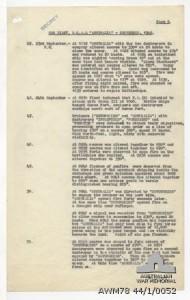“Operation Menace”- the story of HMAS Australia in African waters.
The end of September marks the 80th anniversary of the battle of Dakar. Also known as “Operation Menace”, this operation was endeavoured to be peaceful, with the aim of placing General Charles de Gaulle in leadership at Dakar. It was a significant attempt to set up a Free French government in Dakar (West Africa) by British, French and Australian forces. The Royal Australian Navy Reports of Proceedings,digitised in 2011, highlight HMAS Australia’s three day skirmish with the Vichy French.
HMAS Australia started her duties at Dakar on the 19th of September before the official dates of 23rd to 25th of September, 1940. The Australia landed the chore of tracking and “shadowing” French Vichy ships. Des Shinkfield, in his book HMAS AUSTRALIA: a lucky ship, describes the chase of the ship Gloire, “the climax came about midnight. Australia was steaming at full speed through a rain squall when, suddenly, on passing out of the rain squall into brilliant moonlight, there, on the starboard beam, and heading for Australia was Gloire, only a cable or two away. A collision appeared inevitable. Only the smart handling of the ship by Captain Stewart averted what would have been a major disaster.” Captain Stewart’s account of the incident features in the Reports of Proceedings with a description of the Gloire as a ‘lone bird’
What then ensued was ship to ship stalking as the Australia stuck to Gloire’s tail to guarantee she was safely ensconced in Casablanca. Captain Stewart warned the captain of Gloire that if the Australia were attacked by submarines then they would engage in battle with the Gloire. Needless to say the Gloire assured him that they would be very civil! Captain Stewart suggests in the Reports of Proceedings, that the captain of Gloire was fearful and explains “I have no doubt...he went through an anxious moment when I encountered him on opposite courses and put my searchlight on him on the night of the 19th September”. The Australia forced the Gloire on towards Casablanca; however the Gloire did finish part of the journey herself, and the Australia back-tracked to re-assemble with her team.
The cruiser HMAS Australia (foreground) escorts the Vichy French cruiser Gloire towards Casablanca to ensure that she did not reinforce the Grench force at Dakar prior to Operation Menace, then imminent. 20-09-1940.

During the ensuing battle for Dakar, the Australia was involved in further skirmishes with Vichy French ships from Dakar. The Reports of Proceedings for the month of September describes an incident with the French destroyer L’audacieux on the 23rd of September in a very matter of fact manner.
Harold Plumber, a sailor on board the Australia, describes this situation with more energy in A Sailors Life when he says “she [the L’audacieux] immediately burst into flames from her bridge and right aft and it was a terrible sight watching the poor devils rushing right forward on the FX to get out of the way as she was one mass of flames.”
During the 24th and 25th the Australia continued to help battle against enemy ships on the seas outside Dakar. There were many incidents where the Australia had to engage in attacking and defensive fire. However by the 25th it was clear that this battle was not going to succeed. Australia lost her “walrus” (aircraft spotter) to the sea, and got hit twice herself by enemy fire. Other allied ships were also suffering the marks of war. This battle was over after the faintest sniff at victory. The HMAS Australia successfully carried out everything thrown at her in Operation Menace, albeit with just a few battle scars to take home.
This article was originally published in 2011.
Further reading
Des Shinkfield, HMAS AUSTRALIA, A lucky ship (Ringwood Victoria: 2001)
Peter Taylor, A Sailor’s Life, Aboard HMAS AUSTRALIA (II) (Western Australia: Peter CW Taylor, 2010)
Reports of Proceedings, HMA Ships and Establishments. AWM78 44/1 HMAS Australia: Reports of Proceedings August 1939-December 1941
Reports of Proceedings, HMA Ships and Establishments. AWM78 44/3 HMAS Australia: Reports of Proceedings August 1939-November 1944

